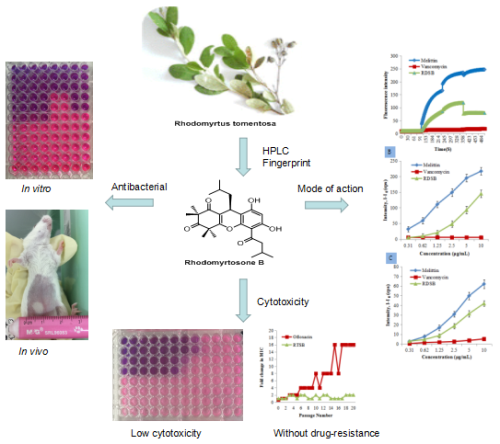Rhodomyrtus tomentosa (Aiton) Hassk., also named as Rose myrtle, is distributed in the hilly areas of Taiwan, Fujian, Guangdong, Guangxi, and Lingnan region. R. tomentosa is a medicinal and ornamental plant, and its sweet fruit is edible. The leaves of R. tomentosa are traditionally used in the treatment of infectious diseases such as wound infections in Chinese traditional medicine.
Liyun Zhao, Ph.D. candidate of the Natural Products Chemical Biology Research Group of South China Botanical Garden, Chinese Academy of Sciences, under the guidance of Prof. Shengxiang Qiu and Associate Professor Haibo Tan, has studied the antibiotic-resistant bacteria activity and mechanism of the rhodomyrosone B, the antibacterial active ingredient was from R. tomentosa. We have found rhodomyrosone B had strong antibacterial activity against Gram-positive pathogens including methicillin-resistant Staphylococcus aureus (MRSA) with a minimum inhibitory concentration (MIC) of 0.62–1.25 μg/mL and vancomycin-resistant Enterococcus faecalis (VRE) with an MIC of 2.5 μg/mL. The membrane-targeting experiments revealed that rhodomyrosone B and its derivatives exhibited significant antibacterial activity with the perturbation of bacterial membrane potential and an increase in membrane permeability. We provided a detailed investigation of the antibacterial action of rhodomyrosone B against bacteria in vitro and in vivo. By screening a series of synthetic derivatives for anti-resistant bacteria activity and structure-activity relationship (SAR), more active (up to 4-5 times) lead compounds were obtained and their antibacterial activity verified in vivo experiment. Notably, rhodomyrosone B has profound antibacterial activity against drug-resistant bacteria (MRSA and VRE) and low cytotoxicity. It is bactericidal in nature, and an increase in membrane permeability resulting from membrane perturbation is one of its modes of action. Rhodomyrosone B represents a promising natural antibiotic to combat drug-resistant (MRSA and VRE) infections.
Related research results have been published in the Journal of Ethnopharmacology (228, 2019, 50-57) and Med. Chem. Commun., (DOI: 10.1039/C8MD00257F). We also have applied the national invention patent authorization ("Myrtle ketone compounds and their application in the preparation of antibacterial drugs", patent number: ZL201510182272.2). The team’s research results in rhodomyrosone B and plant-derived antibiotics provide a material basis for subsequent research on innovative anti-drug resistant antibiotics.
This work was financially supported by the Strategic Resources Service Network Program on Plant Genetic Resources Innovation of the Chinese Academy of Sciences (No. ZSZC-005), National Natural Science, ‘Twelfth Five-Year’ National Science and Technology Support Project of China (2015BAD15B03), Foundation of China (No. 81502949), Guangdong Province Science and Technology Project (No. 2016A010105015), and Natural Science Foundation of Guangdong
Province (2015A030310482).

Fig.1 Rhodomyrtosone B, a membrane-targeting anti-MRSA natural acylgphloroglucinol from Rhodomyrtus tomentosa

Fig.2 Structural optimization and antibacterial evaluation of rhodomytosone B analogues against MRSA strains



